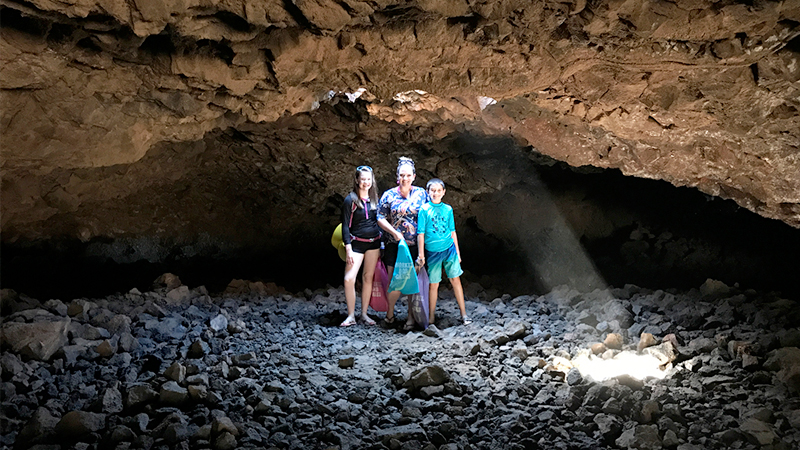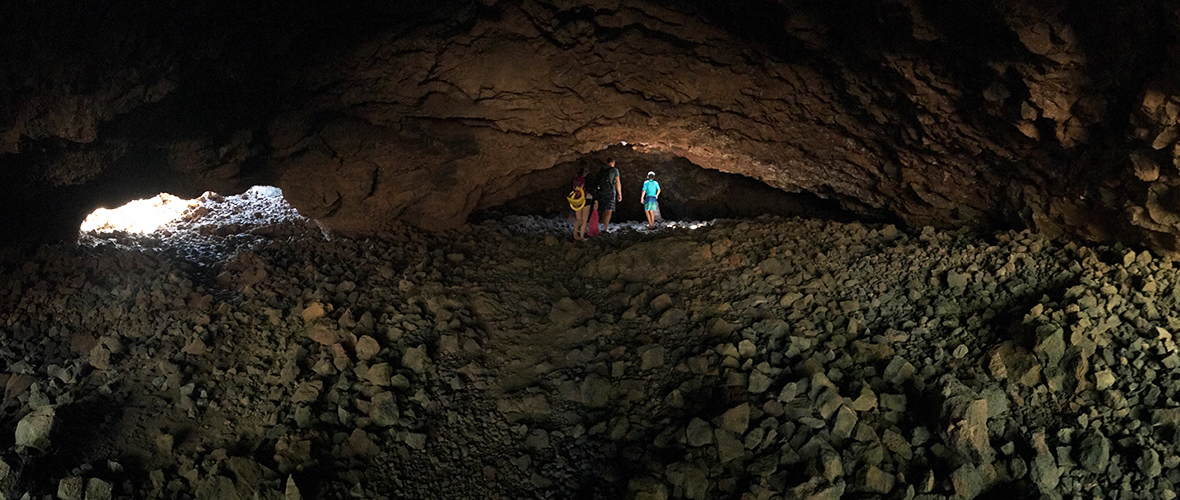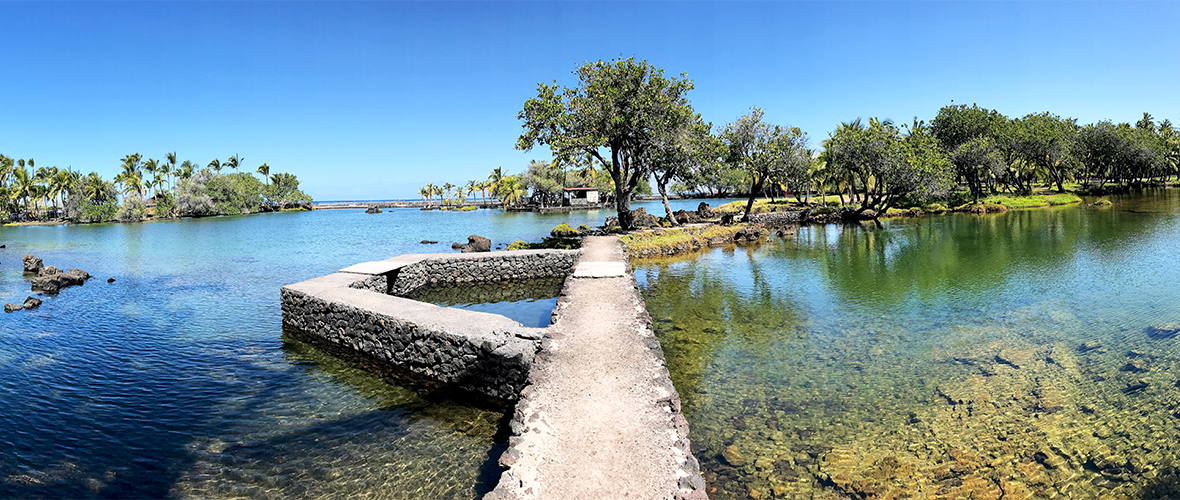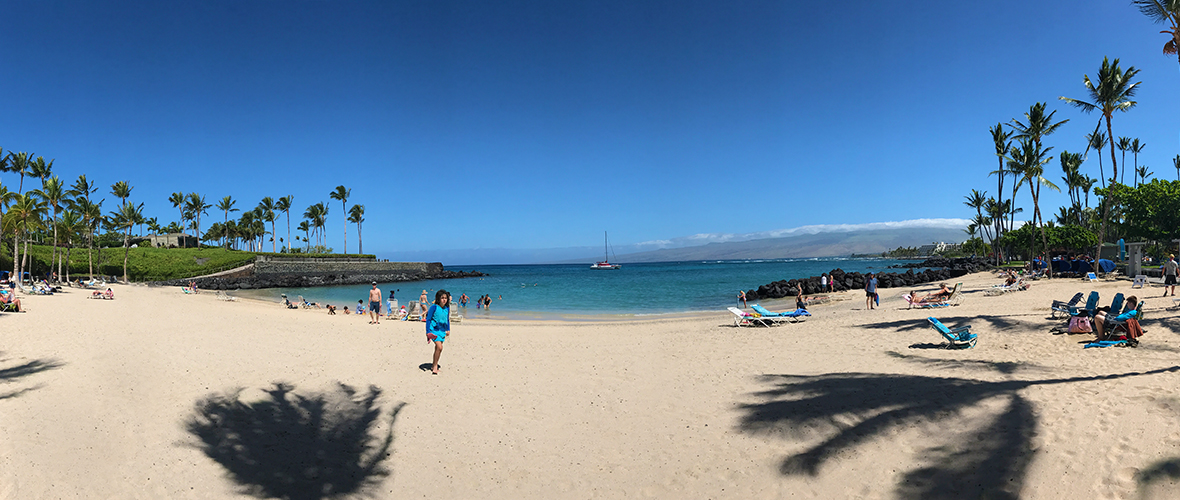
I did a lot of research before our Hawaiian family vacation and visiting the Kalahuipua’a Historic Park And Trails At The Mauna Lani Resort wasn’t even on my list of fun things to do on the Big Island of Hawaii. I had no idea it existed until the staff at Snorkel Bob’s recommended Makaiwa Bay as a great snorkeling location. Makaiwa Bay is on the Mauna Lani Hotel property and the beach is a public beach, but there is one caveat: To get to the beach, you have to follow a paved trail in almost full sun. We almost skipped it because it was the middle of the day and crazy hot, but we went for it anyway because it was windy, we wanted to snorkel, and the beach is protected.
When we arrived at the tiny beach trailhead parking lot, we realized that the trail to the beach was part of the Kalahuipua’a Historic Park And Trails. As part of it’s devotion to preserving and enhancing the cultural history of Hawaii, the Mauna Lani Resort created the park and trails. Walking trails open to the public have been marked throughout the 15 acres of fishpond preserve and the 27 acres of historic park land.
The one mile trail follows a collapsed lava tube. The lava of this ancient flow cooled on the surface first while molten materials continued its passage toward the sea under the newly formed surface crust. When the source of the lava was cut off, the still-molten lava continued its downhill flow, leaving behind empty pipelines called lava tubes. Ancient Hawaiians found the lava tubes to be good living quarters — cooler, drier, and less windy than surface shelters.
According to the Kalahuipua’a Historic Park trail signage, Hawaiians lived in this area for 800 years before the discovery of Hawaii by the western world. That meant along the one mile trail, we were able to walk inside a historic lava tube shelter, see Hawaiian petroglyphs, and view several ancient Hawaiian fish ponds. This adventure was turning out to be totally awesome!
Lava Tube Shelter
After exploring the Bear Gulch Cave and Balconies Cave at Pinnacles National Park, Moaning Caverns, Natural Bridges Cave, abandoned train tunnels at Donner Summit, and California Caverns last year, our family has pretty much fallen in love with any type of cave adventure. Big or small, we love them, and when we figured out that the Kalahuipua’a Historic Park And Trails include an ancient lava tube shelter you can go inside and explore, we were so excited!
In the shelter, beneath the rocky, dusty, barren lava tube floor, archaeologists have found clues that show when people lived in the shelter and what they did during their time there. A story of ancient Hawaiian prehistoric life has been pieced together from the shells, ash, wood fiber, and stone found at the site. For 250 years, this lava tube shelter was home to small groups of Hawaiians who slept, worked, cooked, and ate in the lava tube shelter. The spacious flat floor, shade, protection from the wind and rain, and the cross-ventilation provided by openings toward the rear of the tube made it an attractive location create a home.

Fish Ponds At Kalahuipua’a Historic Park
Situated at the heart of Mauna Lani Resort, seven fish ponds — Kalahuipua’a, Kahinawao, Waipuhi, Waipuhi Iki, Hope’ala, Milokukahi and Manoku — form part of an historic preserve that covers the ancient and more modern history of the area. The Mauna Lani Bay Hotel fish ponds were created by ancient Hawaiians who used them to raise fish and supplement their ocean fishing efforts. The ponds have a combined water surface area of 15 acres and are still home to countless fish. Bottom samples taken from the ponds date the ancient aquaculture system to as far back as 250 B.C. of the fishponds.
Lahuipua’a is the largest fish pond in this area. It once was a natural embayment that the Hawaiians walled off to create a completely enclosed pond. Hundreds of years ago these ponds were shallower than they are today. The gradual sinking of this coastline relative to sea level has steadily increased their depth and area. The smaller pond, Kaaiopio, is now being used as a stocking pond for young ama-ama (mullet) and awa (milk fish).
Utilizing natural anchialine (brackish) pools, most of the fishponds were created by walling off the pools’ natural access to the ocean. Makaha (sluice gates) were incorporated in the walls to allow for circulation of sea water, essential for maintaining healthy fish. The ponds were used to raise ama-ama (mullet), ‘awa (milkfish), shrimp, and other sea. Certain fishes like barracuda and jack enter the ponds from the sea and feed on the young of other fish. These predators must be removed from the pond of the young of more desirable fish species can mature to the size at which they can be harvested.
The fish raised in these ponds were strictly for the consumption by royalty and other persons of rank. Commoners who ate these fish were punished by death.
Continuing the tradition of stewardship and husbandry of the fishponds, Mauna Lani Resort focuses considerable energy on caring for the ancient complex. The ponds are scrupulously maintained and stocked, and the schools of mullet and awa are moved from pond to pond to feed in different stages of development, much like prized cattle are moved from pasture to pasture. Mauna Lani Resort has also planted a variety of ancient Hawaiian plants in an effort to return the ponds to their natural state, edify visitors and preserve a dwindling resource.

Makaiwa Bay On the Big Island Of Hawaii
One arm of the Kalahuipua’a Historic Park Trail ends at Makaiwa Bay near the Beach Club at the Mauna Lani Bay Hotel. Makaiwa Bay is protected on one side by a seawall, which makes it a great protected location for families looking for a place to go snorkeling with kids. The public beach is small, but beautiful — and across the back of the beach you’ll find palm trees, grass, and shade.
For our family vacation in Hawaii, we stayed at the Hilton Waikoloa Village Resort and had a blast snorkeling in their 4-acre lagoon with fish and sea turtles. While on the Big Island though, we wanted to try a few different Big Island snorkel spots and Makaiwa Bay came highly recommended. We walked the one mile historic trail to the beach, carrying all of our snorkel gear and backpacks, and it really wasn’t that big of deal. It was hot, but there was a breeze blowing through the park. Plus, the hike took us past the lava tube shelter that we were able to walk into and explore and ancient Hawaiian fish ponds — really cool!
The beach was beautiful and I’m glad we visited and did the trail walk, but I think if we ever go back to snorkel again, we’ll go early in the morning before many other guests are at the beach. Plus, the snorkeling is better in the morning anyway!

Know Before You Go
- The Kalahuipua’a Historic Park And Trails and Makaiwa Bay at the Mauna Lani Bay Hotel is just north of the Waikoloa Beach Resort on Highway 19. Turn onto Mauna Lani Drive, go straight through the round-about, pass the shops at Mauna Lani (on the right), and turn left on Pauoa Road. Then turn right into a small parking lot.
- The public parking lot for the Kalahuipua’a Historic Park And Trails and Makaiwa Bay only holds about 20 vehicles and has a clean restroom available.
- Kalahuipua’a Historic Park And Trails, including the seven historic Hawaii fish ponds, are open from dawn to dusk.
- The historic trail to the beach is mostly in full sun, so it’s a good idea to wear a rash guard or swim shirt and bring a hat. We applied our sunscreen generously in the parking lot so it would soak in during the mile long walk to the beach. This also helped avoid sunscreen residue in the water while we were snorkeling.
- Be sure you include extra time to explore the ancient Hawaiian artifacts, lava tube shelter, and fish ponds on your way to the beach, because you’re not going to want to do it when you’re wet on the walk back to your car.
- Bikes are allowed on the trail.
- Bring water for everyone in your family — you don’t want to get dehydrated and ruin your day!






